Marketing attribution models: Finding your most efficient marketing channels
In the current business age, companies often run social media ads, email newsletters, webinars, and a host of other outreach methods all at once. So, how do you determine which methods are working and which aren’t? That’s where marketing attribution models come in.
A marketing attribution model is a way for businesses to decipher what outreach is most effective in converting prospects into customers. Using this information, they can learn which touchpoints in their buyer journey are most impactful, leading to improved outreach and ROI.
In this article, we will cover what marketing attribution models are, the different types you can implement in your operations, and how we developed ours at Clearbit.
What is marketing attribution?
Marketing attribution is a way for businesses to determine which marketing method should get credited for a conversion.
In today’s marketplace, companies often run multiple outreach campaigns simultaneously. There may be a mix of PPC campaigns, social media outreach, email marketing, webinars, and more—marketing attribution helps sort out what’s most impactful in generating new business.
Why are marketing attribution models important?
Marketing attribution models are important because they give a business insight into the ROI or effectiveness of each individual outreach method.
To illustrate the process, let’s run through a hypothetical example.
Jen is browsing social media when she comes across an advertisement for AtoZ Creative. She clicks on the ad, and gets routed to a landing page where she inputs her contact information. A few days later, she receives an email that invites her to a free webinar, which she attends. After this webinar, she purchases AtoZ’s offering, and becomes a paying customer.
Here’s the million-dollar question: Which method was most effective in that successful conversion? The webinar? The email? The social media ad? The landing page?
Marketing attribution models make sense of consumer journeys by attempting to answer that very question. Is there a marketing activity that’s present in a majority of sales? Maybe that touchpoint is driving conversions. Conversely, if a marketing activity is consistently absent from sales, maybe that touchpoint needs to be reworked.
With an effective marketing attribution model, a business can double down on which outreach methods are most effective and scrap or rework inefficient touchpoints.
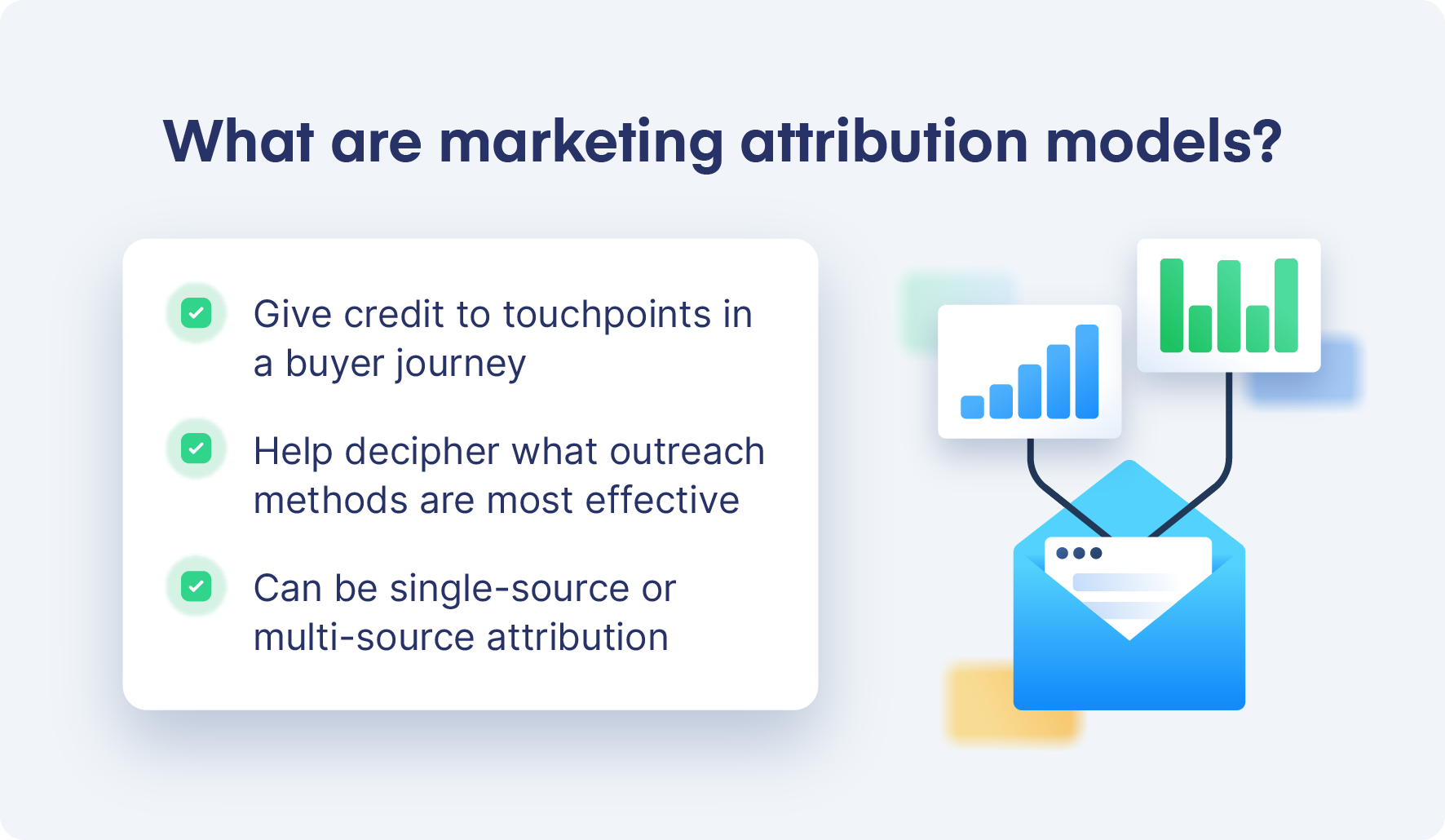
Types of marketing attribution models
Now that you know why marketing attribution models are important, we will cover a few of the most common varieties you can implement in your outreach strategy. You can find all of this information and more in our book, Marketing Attribution.
Single-source attribution
Single-source attribution models give all the credit of the sale to one touchpoint, either the first touch or the last touch. These types of models are a simple way to begin marketing attribution.
First-touch
First-touch attribution models give full credit to the first interaction in a prospect’s journey that led to a conversion. This could be a targeted advertisement, webinar, or downloaded resource—whatever the first measurable point of interaction is.
This type of model could work for businesses that are focused on top-funnel efforts, but a glaring drawback of this attribution approach is that it misses everything that comes after. For example, B2B SaaS organizations typically have a lengthy sales cycle, so a prospect’s first touchpoint may be insignificant compared to the outreach efforts that came later in the process.
Last-touch
Last-touch attribution models give full credit to the last interaction in a prospect’s journey that led to a conversion. Just as with first-touch, last-touch could be any method of outreach—whatever the last point of interaction is before the prospect becomes a customer.
This method could work for businesses that are focused on bottom-funnel conversion efforts, but this type of approach misses everything that comes before. In another example, a prospect may have been nearly convinced to buy before that final webinar or sales call, and this method wouldn’t factor in important outreach steps earlier in that process.
Multi-source attribution
Multi-source attribution models attempt to give proportional credit to each touchpoint in a prospect’s journey. These models are a more advanced method of marketing attribution than single-source.
An important thing to note is that multi-source attribution is not an exact science, and it can be difficult to give one touchpoint most of the credit for converting a prospect. The main takeaway, however, is that these methods make it much easier to determine how effective—or ineffective—certain touchpoints are.
Even distribution
Even distribution models give equal credit to each outreach method in the prospect’s journey.
For example, if the prospect experienced five different touchpoints before converting, each touchpoint would be credited with twenty percent of the sale. This method is more representative of the entire buyer journey than single-touch models, but it can miss the mark on which touchpoint is more or less influential.
U-shaped
U-shaped models give most of the credit to the first and last touchpoints, and even credit to those in between.
In a prospect journey of five touchpoints, the first and last would each be credited with thirty-five percent of the conversion, while the middle three would be credited with ten percent each. Overall, this model is more complicated for a business to implement, but it may give better context to a marketing funnel that has numerous touchpoints.
W-shaped
W-shaped models give most of the credit to the first, middle, and last touchpoints, with any others sharing the remaining credit.
In a prospect journey of five touchpoints, the first, middle, and last would each be credited with twenty-five percent of the conversion, while the second and fourth would be credited with 12.5 percent. Just as with U-shaped, W-shaped attribution models are complex for a business to successfully implement, but when done correctly, they can give more intricate insight.
Time decay
Time decay models give more credit to touchpoints that are done closer to the point of conversion.
Giving an increasing amount of credit to each touchpoint works well for businesses that have a lengthy sales cycle because it gives more weight to recent and relevant actions. For example, a prospect who became a customer today after a sales call may not even remember the first touchpoint (in this case, maybe a webinar) they completed six months earlier.
Custom models
Finally, you can create your own custom attribution model based on what you find most relevant in your buyer cycle. You can draw inspiration from any of the models above or create your own weight system—whatever makes the most sense for your business.
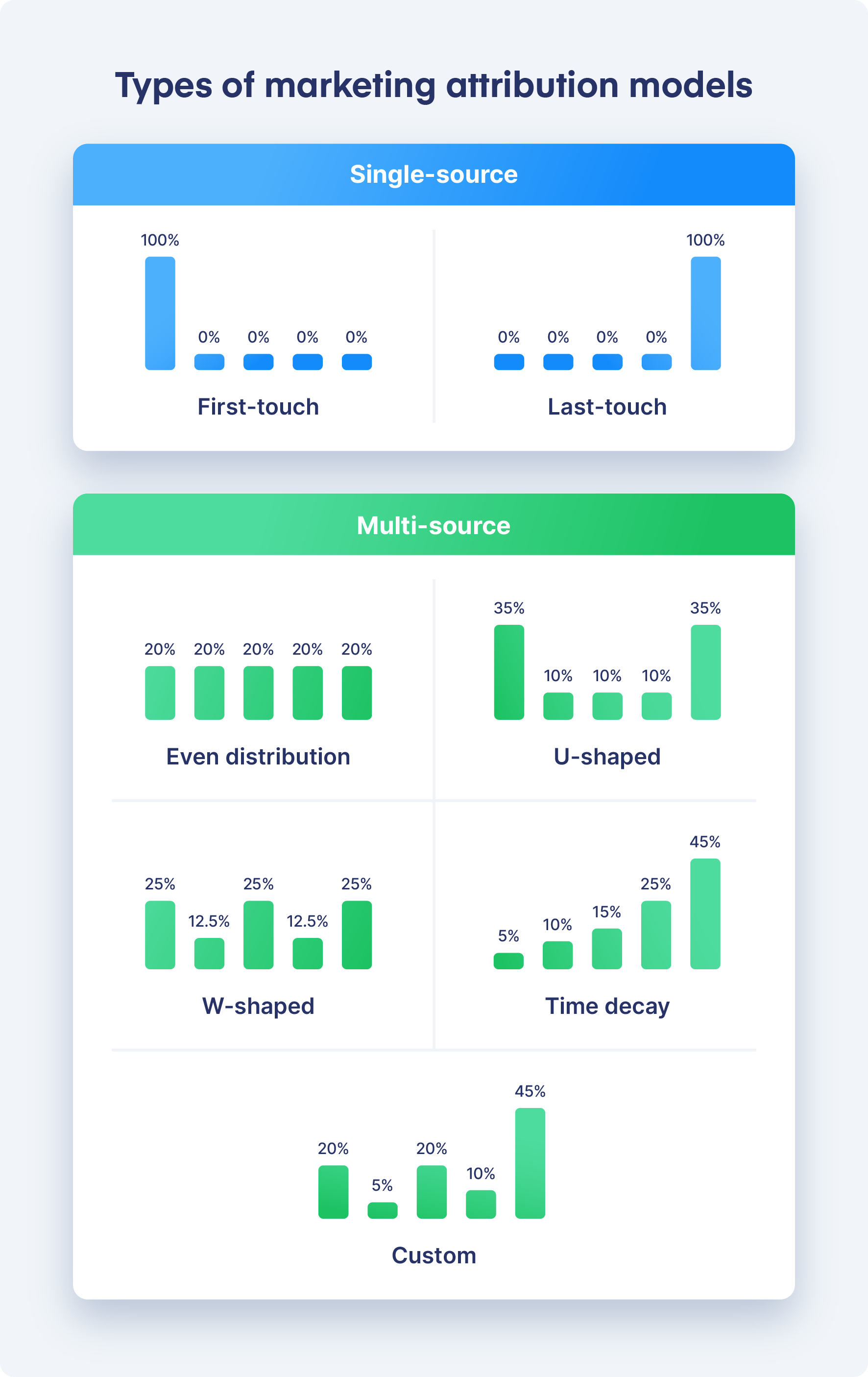
Our attribution model at Clearbit
To give you an even deeper understanding of marketing attribution models, we’ll give you a comprehensive background on how we developed ours.
Here at Clearbit, we measure the dollar impact of our marketing activities with a single-source attribution model, which was built by Julie Beynon, our head of analytics.
Before she joined us, we often found it difficult to see which of our campaigns drove the most revenue and leads. Our earliest analytics tools never quite captured the full picture, as our data was scattered across multiple marketing channels, making it difficult to create a standardized report to see where our revenue was coming from. It was tough to know what worked and what didn’t.
Today, our model is custom-built and combines data from more than ten different sources to show us which campaigns drive the most leads, marketing qualified leads (MQLs), sales qualified leads (SQLs), and subscriptions. This makes it easy for our marketers to do intent scoring for leads, and our sales and success teams to zoom in on individual customer journeys in Salesforce.
Types of lead and customer behavior we capture
Our model pushes behavioral data from our database into our everyday sales and marketing tools, like Salesforce. It’s able to pick up a lead’s (or customer’s) behaviors across virtually any channel or Clearbit product—ranging from our Clearbit Enrichment feature to email interactions to website analytics (which also uses Clearbit Reveal to identify visiting companies).
A few examples of the behaviors we track include:
- Registering for and attending a webinar
- Downloading an eBook
- Viewing a paid social ad
- Reading a blog post
- Signing up for a free account
- Requesting to speak to our sales team
Because our model is custom-built, we have a lot of flexibility in how we gather information—giving us the most comprehensive view of a lead’s journey we’ve ever had.
Showing a lead’s journey in Salesforce
Before we share how the model is built, let’s look at one of the end results: what shows up in Salesforce.
When a user clicks on a Salesforce contact, it will reveal a detailed list of all the marketing channels and content the contact has interacted with. It also marks the converting touchpoints for leads, MQLs, and SQLs.
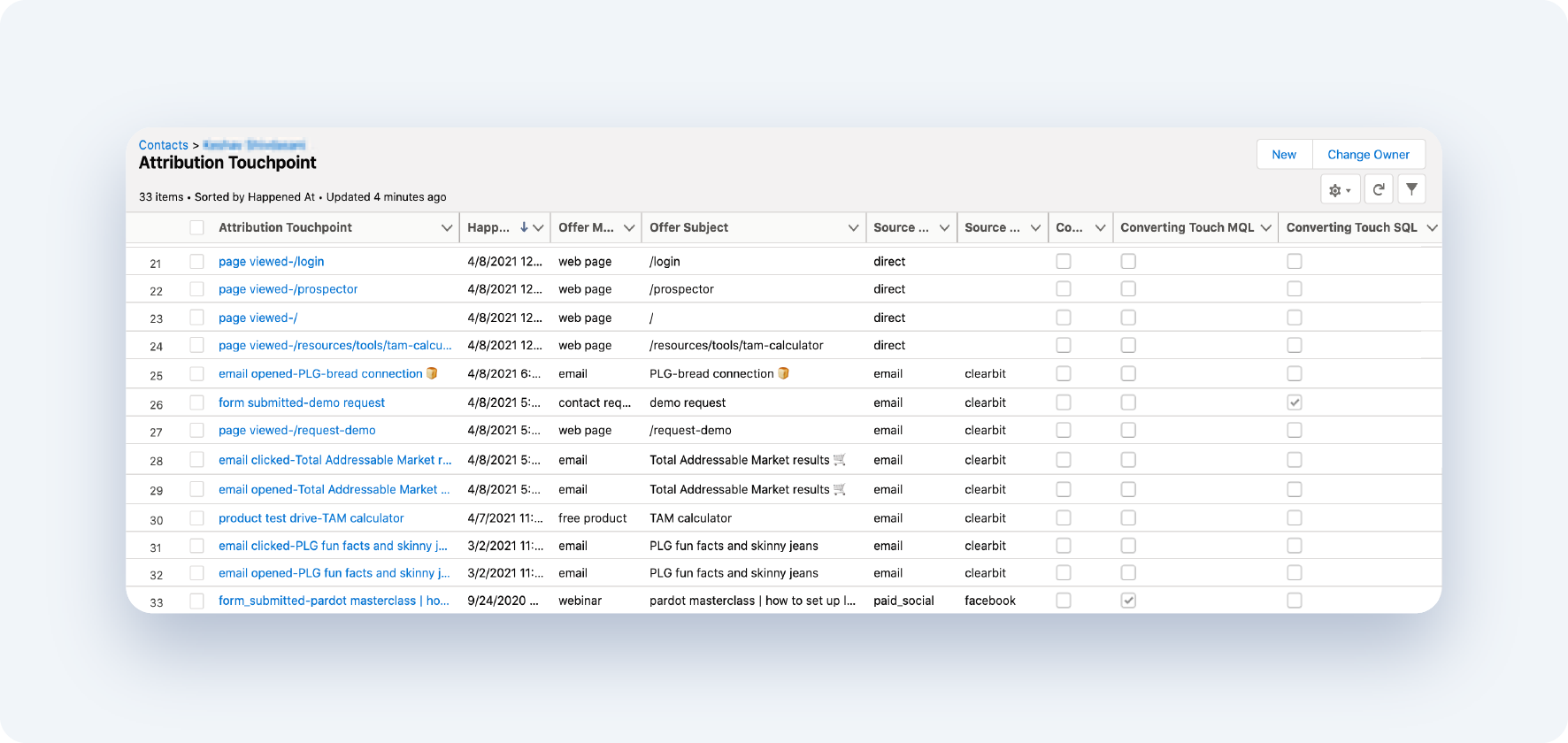
For example, imagine you're a Clearbit salesperson about to hop on a phone call with a lead, and you quickly need to do some research on them. You might see that they entered the Clearbit universe on September 24, 2020, and subsequently, they:
- Attended a webinar via paid social, which was the converting touchpoint for both lead and MQL—but they went cold
- Returned to engage with Clearbit emails for a few months, then opened our "demo request" page and asked to speak to Sales
- Read a few more marketing emails from us, and checked out our TAM Calculator
- Visited a few Clearbit website pages directly, like our Prospector product page
As you can see, this granularity makes conversations more personalized and allows for more effective outreach.
The data pipeline architecture
Now, let's look at the machinery under the hood.
When we set out to create our model three years ago, we couldn't find one tool that met all of Clearbit's needs perfectly—it was difficult to track all behaviors across all Clearbit products and marketing channels in a standardized way.
So, we built a custom model instead, connecting a number of tools based around Redshift as the data warehouse:
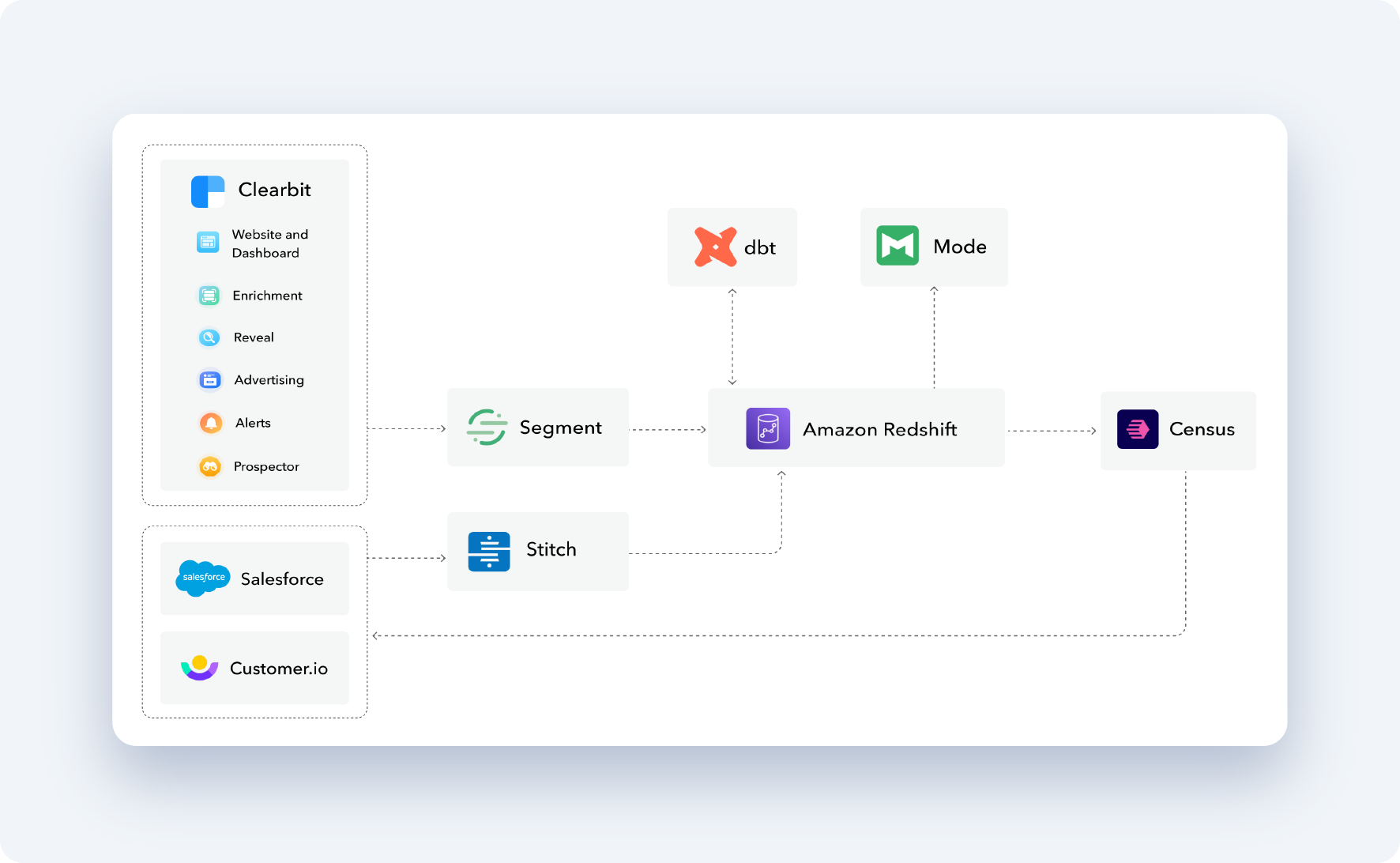
- Data warehouse: Our data warehouse, Redshift, holds all the raw data about user interactions.
- Data collection: Segment sends behavior data—pulling from our website, products, and marketing channels—while Stitch sends behavior and additional data from Salesforce and Customer.io, as sources, to Redshift.
- Data transformation: dbt sits on top of Redshift and does the hard work of transforming the raw data. It combines all data sources into one attribution model table.
- Making data available and useful: Clearbit teammates can query that table (we use Mode), while Census pushes the data into destination tools like Salesforce and Customer.io. Census also handles field mapping to ensure data is formatted properly to sync to those tools.
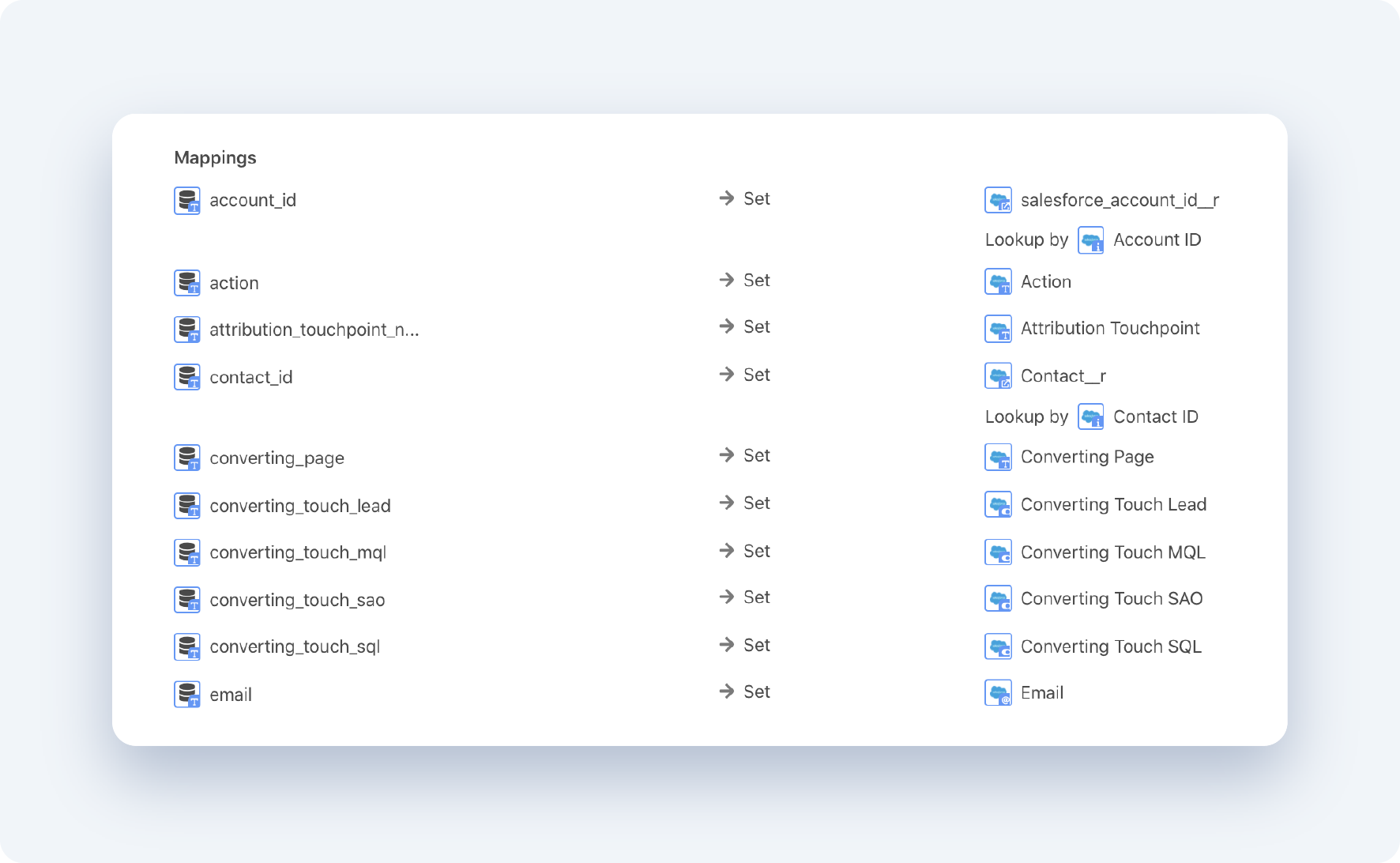
The attribution model is connected to a separate tech stack for lead qualification, owned by the Clearbit RevOps team—which is centered around Salesforce, and uses tools like MadKudu to score new leads and LeanData to route them.
Our two models—the RevOps stack based on Salesforce and our stack on Redshift—also sync and share data via Census, a reverse ETL, as well as via Stitch, an ETL.
Our final attribution model
Our final attribution model table shows everything that's happened in a user's journey, based on user events we set up in dbt—things like “webinar attended,” “eBook from submitted,” “blog signup,” and more. As of now, we track about thirty events.
Our model ties in firmographic and product usage data to tell us whether a lead is an MQL, PQL, or ideal customer. The MQL/PQL distinction guides sales outreach by indicating their purchase or sales readiness based on whether they've had more interactions with our products or with our emails, eBooks, and events.
Additionally, this attribution model has enabled us to start building an intent scoring model in dbt, which gives each user a trailing thirty-day engagement score to indicate how much they've interacted with Clearbit in the last month. Armed with this information, we can see the percentage of our target audience that has been active lately, and how that's changing over time with our marketing and sales efforts.
How to choose an attribution model for your business
Marketing attribution models aren’t one-size-fits-all. To choose the right method for your business, you need to determine your goals and what information regarding the buyer journey is important to you.
There are three different approaches to establishing an attribution model:
- Specific approach: Are you primarily concerned with a specific touchpoint in your buyer journey? You might want to consider starting with a first-touch or last-touch attribution model and evaluate how it performs.
- Holistic approach: Maybe you want a larger view of how all your outreach is received throughout the buyer journey—it may make sense to start with a U-shaped, W-shaped, or time decay model.
- Custom approach: When you know you want something but aren’t quite sold on the previous models, it might be time to take matters into your own hands and build a custom model for your business.
Marketing attribution model FAQ
Finally, we will wrap up with a few frequently asked questions about marketing attribution models.
What is the best marketing attribution model?
There is no “best” marketing attribution model—it all depends on the needs of your business and what information you want to gather. Some businesses would do well with a first- or last-touch approach, while others would prefer a time decay or custom model. It all depends on your goals.
What is an example of an attribution model?
There are many different attribution models, but a few examples include first-touch and last-touch models, U-shaped, W-shaped, and time decay.
How do you create a marketing attribution model?
Simply put, you can create a marketing attribution model by determining your goals, establishing important touchpoints, and setting up a system with the software and platforms your team uses every day. At Clearbit, our model is built on the backs of dbt, Amazon Redshift, Segment, Salesforce, and more.
Clearbit can aid your marketing attribution
Marketing attribution models are key for a business to determine which outreach methods are most effective at turning prospects into customers. That said, it can be difficult to set up a proper model without the proper tools.
At Clearbit, we have a host of capabilities such as data enrichment, lead scoring, and ad targeting to help you determine where your prospects are coming from and how best to perform outreach for maximum ROI.

